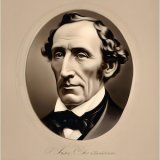The Dryad Page #2
"The Dryad" is an intricate tale by Danish fairy tale legend, Hans Christian Andersen. The storyline follows a Dryad - a mythological tree spirit - who impatiently longs to explore beyond her solitary existence in a grand ancient tree. Lured by the festive glamour of the Paris exhibition, she abandons her roots only to find the bustling, industrialized city overwhelming and herself feeling lost and homesick. In this narrative, Andersen explores themes of nature, industrialization, alienation, and longing.
Genre: Children
Genre: Children
- 21 Views
whole landscape, as far as the Dryad's eye could reach. Like enormous blue-black blocks of rock, the clouds lay piled over one another. Gleams of lightning shot forth from them. "These also are the servants of the Lord God," the old clergyman had said. And there came a bluish dazzling flash of lightning, a lighting up as if of the sun itself, which could burst blocks of rock asunder. The lightning struck and split to the roots the old venerable oak. The crown fell asunder. It seemed as if the tree were stretching forth its arms to clasp the messengers of the light. No bronze cannon can sound over the land at the birth of a royal child as the thunder sounded at the death of the old oak. The rain streamed down; a refreshing wind was blowing; the storm had gone by, and there was quite a holiday glow on all things. The old clergyman spoke a few words for honorable remembrance, and a painter made a drawing, as a lasting record of the tree. "Everything passes away," said the Dryad, "passes away like a cloud, and never comes back!" The old clergyman, too, did not come back. The green roof of his school was gone, and his teaching-chair had vanished. The children did not come; but autumn came, and winter came, and then spring also. In all this change of seasons the Dryad looked toward the region where, at night, Paris gleamed with its bright mist far on the horizon. Forth from the town rushed engine after engine, train after train, whistling and screaming at all hours in the day. In the evening, towards midnight, at daybreak, and all the day through, came the trains. Out of each one, and into each one, streamed people from the country of every king. A new wonder of the world had summoned them to Paris. In what form did this wonder exhibit itself? "A splendid blossom of art and industry," said one, "has unfolded itself in the Champ de Mars, a gigantic sunflower, from whose petals one can learn geography and statistics, and can become as wise as a lord mayor, and raise one's self to the level of art and poetry, and study the greatness and power of the various lands." "A fairy tale flower," said another, "a many-colored lotus-plant, which spreads out its green leaves like a velvet carpet over the sand. The opening spring has brought it forth, the summer will see it in all its splendor, the autumn winds will sweep it away, so that not a leaf, not a fragment of its root shall remain." In front of the Military School extends in time of peace the arena of war--a field without a blade of grass, a piece of sandy steppe, as if cut out of the Desert of Africa, where Fata Morgana displays her wondrous airy castles and hanging gardens. In the Champ de Mars, however, these were to be seen more splendid, more wonderful than in the East, for human art had converted the airy deceptive scenes into reality. "The Aladdin's Palace of the present has been built," it was said. "Day by day, hour by hour, it unfolds more of its wonderful splendor."
Translation
Translate and read this book in other languages:
Select another language:
- - Select -
- 简体中文 (Chinese - Simplified)
- 繁體中文 (Chinese - Traditional)
- Español (Spanish)
- Esperanto (Esperanto)
- 日本語 (Japanese)
- Português (Portuguese)
- Deutsch (German)
- العربية (Arabic)
- Français (French)
- Русский (Russian)
- ಕನ್ನಡ (Kannada)
- 한국어 (Korean)
- עברית (Hebrew)
- Gaeilge (Irish)
- Українська (Ukrainian)
- اردو (Urdu)
- Magyar (Hungarian)
- मानक हिन्दी (Hindi)
- Indonesia (Indonesian)
- Italiano (Italian)
- தமிழ் (Tamil)
- Türkçe (Turkish)
- తెలుగు (Telugu)
- ภาษาไทย (Thai)
- Tiếng Việt (Vietnamese)
- Čeština (Czech)
- Polski (Polish)
- Bahasa Indonesia (Indonesian)
- Românește (Romanian)
- Nederlands (Dutch)
- Ελληνικά (Greek)
- Latinum (Latin)
- Svenska (Swedish)
- Dansk (Danish)
- Suomi (Finnish)
- فارسی (Persian)
- ייִדיש (Yiddish)
- հայերեն (Armenian)
- Norsk (Norwegian)
- English (English)
Citation
Use the citation below to add this book to your bibliography:
Style:MLAChicagoAPA
"The Dryad Books." Literature.com. STANDS4 LLC, 2024. Web. 21 May 2024. <https://www.literature.com/book/the_dryad_2158>.




Discuss this The Dryad book with the community:
Report Comment
We're doing our best to make sure our content is useful, accurate and safe.
If by any chance you spot an inappropriate comment while navigating through our website please use this form to let us know, and we'll take care of it shortly.
Attachment
You need to be logged in to favorite.
Log In